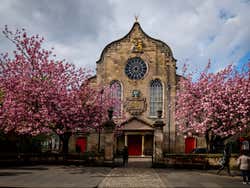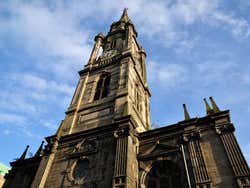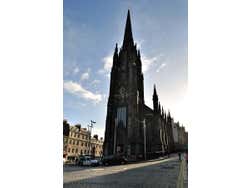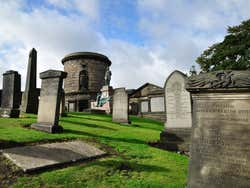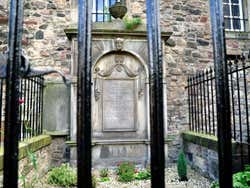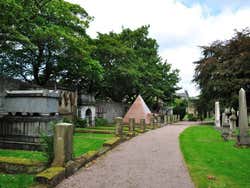
Churches and Graveyards in Edinburgh
Edinburgh has numerous churches and cemeteries worth visiting. Below you'll find a list with the best and most interesting temples and graveyards.
Churches (Kirks)
Canongate Kirk
The modest Canongate Kirk was built in 1688 and completed three years later. It was founded for the residents of Canongate that had previously worshipped in the Abbey Church, until King James II converted the Church into a Chapel for the Order of the Thistle.
Since the church is very bare, with practically no statues or paintings, the most eye-catching aspect of the temple is its blue benches on a maroon coloured carpet. The walls are spotless and the windows let in a lot of light because these are not stained-glass.
Canongate Kirk is the Royal Family’s favourite church. When they stay in Edinburgh, you'll see them in attendance, on the front rows that are reserved for them.
St Margaret’s Chapel
The small St Margaret’s Chapel located in Edinburgh Castle was founded in honour of the mother of King David, Princess Margaret. It is the oldest surviving building in Edinburgh.
Tron Kirk
Tron Kirk is an old Presbyterian church. It was established during the seventeenth century and was the main parish church in Edinburgh from 1648 until 1952. It was named “Tron Church” because the temple was located beside a weighing beam (tron in Scots), which was normally used in the town's marketplaces, one of which was on the Royal Mile.
In 1824 a great fire destroyed the bell tower, but it was reconstructed so well that visitors will hardly notice that it was built two hundred years later.
Tron Kirk was closed as a church in 1952 and was then used as a tourist information centre for a little while until it was transformed into a Victorian market.
The Hub
The Highland Tolbooth Kirk is a gothic style church established between 1842 and 1844. It has the tallest spire in Edinburgh, measuring 71.7 m.
Highland Tolbooth was closed as a church in 1979 and was unused until it became “The Hub” in 1999. It is home to the Edinburgh International Festival, where several music events take place in its interior and the Tickets box office is located.
Greyfriars Kirk
Greyfriars Kirk is situated on the south side of the Grassmarket. Built between 1602 and 1620, it is one of the oldest buildings in the city.
The church is surrounded by Greyfriars Kirkyard (cemetery) where following the defeat of the Covenanters in 1679, some 1200 men were imprisoned on the south side of the church. During the eighteenth century, the prison became part of the kirkyard and was known as the “Covenanters Prison”. The Covenanters was a national Presbyterian movement who were opposed to the interference of the Stuart kings in the Presbyterian Church of Scotland.
Greyfriars Kirk was divided into two congregations until 1929, when it merged and the building was restored. It is currently one of the few churches that continues to give mass in Gaelic and English.
Cemeteries
Greyfriars Kirkyard
Although Greyfriars Kirkyard is where numerous important Scottish people have been buried, it is best known as the burial site of Greyfriars Bobby, the most loyal dog in Edinburgh, who remained by his owner’s grave for fourteen years.
Another famous character is the ghost of Sir George Mackenzie, known as “Bluidy Mackenzie”. Mackenzie was a Scottish lawyer who is said to haunt his last resting place and spook citizens and tourists that come to the graveyard.
Canongate Kirkyard
Canongate Kirkyard, surrounding Canongate Kirk, is famous as the resting place of Adam Smith, considered the father of modern capitalism. His grave is located near the entrance of the cemetery, next to a wall on the left side of the church.
Old Calton Burial Ground
Old Calton is situated at the foot of Calton Hill and is the resting place of numerous important people including the philosopher David Hume.
Inaugurated in 1718, the cemetery had to be altered due to the construction of Waterloo Place in 1819 and was divided into two.
As well as the neoclassical memorial of David Hume, it is also worth highlighting the tall black obelisk erected in the memory of a number of political reformers and an enormous statue of Abraham Lincoln which is Scotland’s American Civil War Memorial.
Dean Cemetery
Dean Cemetery was inaugurated in 1846 and belongs to a beautiful hamlet located very near the city centre called Dean Village. It is one of the most remarkable cemeteries in Edinburgh and if it weren’t for the gravestones it could pass as a tranquil park full of trees.
